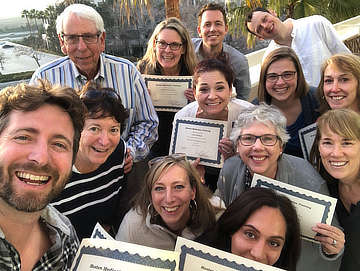Depositioning with Client Self-Interest or
What to do when clients are stuck to their guns
By Max Markin | July 9, 2020
Key Points
- Depositioning with Client Self-Interest is a mediation technique taught by Forrest “Woody” Mosten
- It helps the mediator to shift the client’s focus from positions to interests
- Before employing this technique, try simply asking Why?
Overview of the Method
- Summarize the client’s position, and check that you’ve got it right. Acknowledge that the other party has been unwilling to accept this position.
- Ask the client to imagine that they get their way.
- Ask them how they benefit. What do they get, when they get their way?
- List the benefits (their underlying interests). Capture all of them. “Bleed the position dry”.
- Review the list of benefits and ask the client, “If all of these needs could be met by some other solution, would you be open to considering it?”
Stuck to Their Guns
“Stick to your guns” seems to fall in the same category of old school negotiation advice as “never make the first offer” and “don’t let emotions get in the way”. And to a certain point, it may be a solid recommendation. Experts suggest maintaining an initial set of positions in negotiation, at least until you have a solid understanding of the other party’s priorities. An obvious limitation of positional bargaining however, is that it tends to fuel a competitive mindset that may not allow for consideration of mutually agreeable outcomes.
In mediation, our stated goal is to pursue mutually acceptable outcomes. To do so, it is generally necessary to move beyond the parties’ initial positions. This is one of the main ideas in Ury and Fisher’s classic Getting to Yes, which encourages us to “focus on interests, not positions”. It can be a real challenge for people to do this, especially when they are fearful or resentful, as may be the case in divorce mediation.
In this post, I describe a mediation technique called “Depositioning with Client Self-Interest”. Mediators can employ this method to help “stuck” clients move past their positions, identify their underlying interests, and ultimately acknowledge a willingness to consider alternative outcomes.
40 Hours Well Spent
Back in late January (before 2020 took a turn for the worse), I had the pleasure of attending a 40-hour mediation training in San Diego, taught by master mediator and trainer Forrest “Woody” Mosten. The program was a good reminder that just because you have already taken a basic training (or two), it doesn’t mean you shouldn’t attend another. In fact, Woody recommends that new mediators take three 40-hour trainings…in their first year!
Each time I attend a basic training, I learn new things and deepen my understanding of the concepts that I am already familiar with. Each trainer offers something special, and the content that does overlap tends to be fundamental stuff that it doesn’t hurt to review.
For me, one of the highlights of Woody’s program was what he calls “Depositioning with Client Self-Interest”. Depositioning is a technique for helping clients be more flexible with their demands without giving up the things that are important to them. It’s a practical strategy for helping parties follow Ury and Fisher’s prescription to focus on interests rather than positions.
Here’s how it works…
Just Ask Why
The most basic depositioning technique is to simply ask, “Why?”
During one of the role plays in San Diego, I was struggling to work out a parenting schedule for a contentious couple. The wife didn’t want the child to have any overnights with the dad, and the dad was asking for equal parenting time. Woody asked me to pause.
“Just ask why”, he said.
As I fumbled to summarize their positions, and set myself up for an incisive ‘why’ question, Woody repeated himself.
“Just ask why”, he said. “Just… why?”
I turned to the wife and asked, “Linda, why don’t you want the children to stay at John’s house?”
A few minutes later, I was able to pose a similar question to the husband, “John, why is ‘equal time’ so important to you?”
We had movement. It was no longer a tug-of-war to see who could more firmly stand their ground. These simple ‘why’ questions opened up an impassioned dialogue between the parents about what was important to each of them and what their concerns were for their children.
To Caucus or Not to Caucus
Mediators tend to have strong feelings about when it is appropriate to meet with the parties individually, that is, to “caucus“. For a fine discussion of the subject, check out Laurie Israel’s article To Caucus or Not To Caucus – That is the Question.
To make a long story short, Woody does not object to strategically meeting with clients one-on-one, and he recommends doing so when employing this method.
Depositioning With Client Self-Interest
Step 1: Acknowledge the Problem
The first thing to do is to summarize the parties’ current positions and acknowledge that they are incompatible. Although they are not yet ready to, the parties want to reach an agreement. That’s why they are in your office. Acknowledging that their current positions are incompatible, suggests that considering other options may be necessary.
Step 2: Give Them What They Want
This is the secret ingredient to “Depositioning with Client Self-Interest”. This is where Woody’s method succeeds, while other less skillful approaches can easily backfire.
If you try to push or pull someone from a position, by criticising it or offering up unsolicited alternatives, they are likely to become defensive and just “dig in” harder. However, by giving the person what they are asking for (even hypothetically), you may afford them the security they need to loosen their grip.
This method respects the fact that parties’ positions are not arbitrary. It trusts that if we give the client some room, and work together with them to examine their position, we can cultivate an understanding of why it is they are asking for whatever they are asking for.
You might say something like, “Let’s imagine that John were to agree to a parenting schedule with no overnights. I don’t think that he is going to. But, let’s just pretend that he did…”
Step 3: What Do You Get When You Get What You Want?
Once we’ve reassured the client that we are not attacking their position, we can get into the real work of collaboratively uncovering their interests. Ask the client to consider what they actually get when the other party accepts their position. How does this outcome benefit them? How might it benefit their children?
Use a visual aid. Write their responses on the flip chart or white board.
Step 4: Bleed the Position Dry
It is important that we fully exhaust the benefits afforded by the party’s current position. Spend some time on this, and don’t let anything slip through the cracks. If we miss an important interest here, it could come back to haunt us later. Use your mediation “micro skills”. Review the list and summarize. Ask open-ended, clarifying questions. If you think of a benefit that the party hasn’t mentioned, ask for permission before suggesting it.
Step 5: Invite Them to Consider Other Options
Once we have an exhaustive list of the benefits of the party’s current position, we can ask them the critical question. “If all of these needs could be met by some other solution, would you be open to considering it?”
If you’ve done your work in the previous steps, it should be hard for the client to say “no” to this question. If they say “yes”, the intervention was a success.
“Baby Steps”
This definition of success reminds me of another important takeaway from Woody’s training. He taught us to appreciate the power of small accomplishments, or “baby steps”, as he calls them. Over time, incremental progress can produce impressive results.
When the parties are firmly maintaining incompatible positions, it is not realistic to expect spontaneous agreement. Under such conditions, our short-term goal as mediators should be to restore the constructive potential of the dialogue. “Depositioning with Client Self-Interest” is a powerful strategic tool for making this happen.
 Max Markin, Assistant Director
Max Markin, Assistant Director
I am a divorce mediator, practicing in Brooklyn and online. I have had the privilege of working closely with some of the country's top mediation trainers at the Center for Mediation & Trianing. As founder of Markin Mediation, I strive to integrate established mediation techniques with new technology, to provide the most efficient and effective process for my clients.

